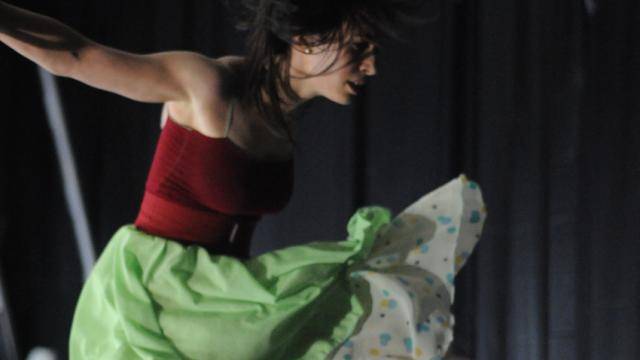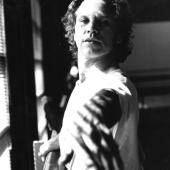The Ford Theatre kicked off its summer dance series last weekend with a double bill featuring BODYTRAFFIC and L.A. Contemporary Dance Company/SONOS. BODYTRAFFIC co-directed by Lillian Barbeito and Tina Finkelman Berkett opened the program with Transfigured Night. It takes its name from the iconic Schoenberg score (1899 for string sextet) on which it is based. The choreography by Guy Weizman and Roni Haver was seen in 2009 at Sinai Temple with live music. Casting and other changes have improved its presentation. LACDC offered its premiere of Gods and Marionettes, choreography by Kate Hutter, music by Christopher Given Harrison and concept by David Bridel, Hutter, and Harrison. It features the vocal group SONOS, who supply the music, beatboxing and sound effects while participating in the action.
BODYTRAFFIC's version of Transfigured Night takes as its purpose a delineation of space and time, movement and stillness as well as themes of the Holocaust. It is interesting that this music in the hands of Tudor was used for a bleak love story (Pillar of Fire) but here is abstracted to the extreme, creating a wholly new context. What seems held in common is a heaviness and rare moments of relief. These dancers move through a set - a striking assemblage of metal tubes lit from within - created by Ascon de Nijs whose intent is to create an atmosphere of suppression, and crumbling architecture. For me they ruptured the dance space challenging the dancers with obstacles to overcome. Perhaps this piece tries to deal with too many elements at once; but as it unfolds we know we are in the presence of deep thinking and a powerful effort to reconcile elements of movement both weighty and joyful which take place in sacred and profane realms. The movement is mostly organized around the music but also proceeds with long sections danced in silence.
The women's roles, strikingly danced by Finkelman Berkett, Julie Rose Friedrich and Ja Young Kim donned very personal and idiomatic personas throughout. The men, Hai Co-hen, Liony Garcia and Jordan Isadore dance with more unity of expression and style. Attired in white suits, they looked joyfully airborne in one of the ensemble sections. The company managed the tilting, confined spaces of the Ford stage with care but I missed what seemed like a more expansive stage at the Sinai Temple concert. A row of chairs slightly off stage and elevated acted as a refuge for the dancers between sections and accommodated costume changes.
At the end we are lifted by a final tableau with Berkett - excellent throughout - as she sleeps, despairs, dies? wrapped in red fabric. It was a moment both serene and shattering. Perhaps the peace found here only comes with great cost and awareness.
Other credits: Brian Gale and Barbeito, lighting and costumes by Swinda Reichelt.
The second half of the program brought LACDC in conjunction with SONOS for a look at the modern world imagined in terms of Greek Tragedy. The conceit: the dancers are the players, SONOS (an a cappella choir) the chorus, and Will Harris is the jovial demi-god, commentator and puller-of-strings. Gods and Marionettes is incredibly clever in many regards not the least of which is an effective and fully integrated use of music, the spoken word, theater and of course dance. It addresses the nature and sources of our ac- tions with both gritty realism and offhanded humor. Hutter is to be commended for making this all work. Part of the work was previewed earlier this spring at the Brockus Project Studios. The polish and scope applied since then attests to a phenomenal amount of work and shaping. At times, the mingling of dancers and singers proved messy on stage. Singing and vocal elements were complex but ably handled by an uncredited technician and ran glitch-free -- no small achievement. The theater's architecture was well used with sections taking place in the orchestra seating area as well as the stairs rising on the hillside. It gave the production the real amphitheater effect: outdoors, epic and spilling over. Notable ensemble sections were cohesive and well danced. Stand-out individual performances were offered by Kevin Williamson and Drea Sobke. Paul Peglar of SONOS and company dancer Devin Fulton were also effective in their passionate duo. Fulton also made a bold statement keening wildly in the final tableau as the lights failed to go to black on cue. Bridel's written text had an appealing sense of improvisation and played well against the spontaneous delivery of Will Harris. It became an elevated standup act, just what you expect from a prankster demigod.
Other credits include: lighting by Brian Gale, costuming by Alexis De Forest and choreography by Hutter. SONOS is directed by Hugo Vereker.
At the conclusion, Hutter in brief remarks from the stage thanked the Ford and made her pitch for local companies and the audiences who love them. Her “no imports here” reflected the evening's title: MADE IN LA. A very full house acknowledged her comments with applause and appreciation. The glow was in the house.
Across town at the Luckman, Raiford Rogers Modern Ballet held forth with its once yearly installment performed by a mostly pick-up company with heavy borrowings in the cast from Sacramento Ballet. The program, Hammerklavier, offered premieres by Rogers to three movements from the late Beethoven piano sonatas. While Rogers self identifies his company as modern there is very little here that truly offers testament to that fact. Ironically, the rarified and challenging world of these late sonatas with all their strangeness and enormity seemed more modern than what we saw on stage. A relentless sameness of movement and stasis never permitted the dancers a chance to reach out and convince us of anything, so stuck were they with soldiering on with fussy movement, balances and arms upraised throughout as if trapped in a never-ending stick-up. The ADAGIO from the Hammerklavier sonata ran against full screen projections of faces. The overlay did not help clarify any intent concerning the piece.
Obvious chances were missed - for instance in the Gesangvoll variations - to give us easily made contrasts and a structure fitting with the music as it moves from section to section. This music moves ever slowly growing exponentially in density yet we feel none of this as the dancers come and go, dancing with no real purpose or even interest. It is difficult to latch onto what Rogers is trying to get at here and why it should all seem so derivative and bland from beginning to end. At times the movement is difficult, forcing the dancers to balance in relevee, point and extend, and lunge mightily but the effort of getting it done always seemed to make less of the music rather than more. Instead of giving us three differing visions of these slow moving pieces we get the same one, three times. In the end we are saved by the music alone.
Lighting by Monique L'Heureux was a welcome bright spot. The weighty blue light floated across the grey/white floor for Gesangvoll even made the air seem blue and alive. The dancers too were wonderful and occasionally athletic. The men in ARIETTA provided welcome relief with bounding movement danced effectively and powerfully. The limited partnering looked sure when it happened. The costumes - unitards with short sleeves and legs cut mid thigh -- all red for the first piece and black for the rest -- were unimaginative. It was a particularly unflattering look for the women. Two pieces not identified on the program made for some audience confusion in the heavily papered house. At least this company avoided the pain of the empty houses at the last two Luck- man dance events -David Dorfman and ODC - which were excellent evenings of terrific modern dance. The last of two unidentified pieces was an instrumental bolero -- Mexico style ,with Flaco Jimenez and company. Cowboy hats and unisuit prevailed for this final slow dance too - a bow, sweetener after the mighty Beethoven? Quien sabe? Other credits included: costumes by Yumiko, photography by Ed Evans, video editing by Mark Bowen.
Check out the upcoming Ford Theatre events. There is a wide ranging program of dance scheduled for the summer!
(June 18 & 19, 2010 BODYTRAFFIC and L.A. Contemporary Dance Company at the Ford Theatre Raiford Rogers Modern Ballet at The Luckman Theater)




